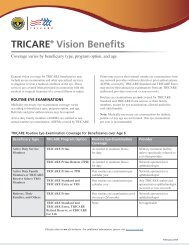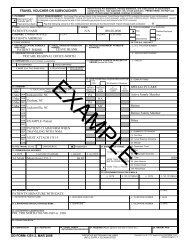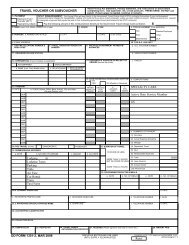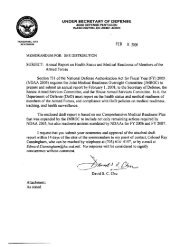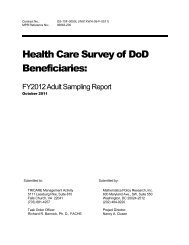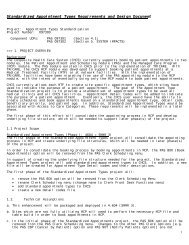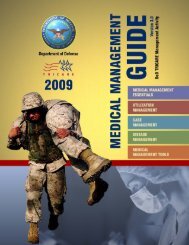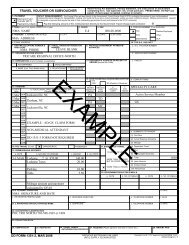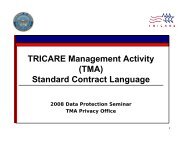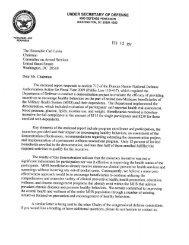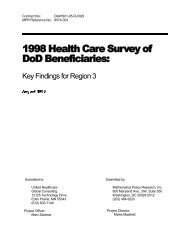2006 HCSDB Adult Sampling Report - Tricare
2006 HCSDB Adult Sampling Report - Tricare
2006 HCSDB Adult Sampling Report - Tricare
- No tags were found...
You also want an ePaper? Increase the reach of your titles
YUMPU automatically turns print PDFs into web optimized ePapers that Google loves.
<strong>2006</strong> HEALTH CARE SURVEY OF DOD BENEFICIARIES*HRJUDSKLF$UHDThe definition of geographic area depends on the beneficiary’s enrollment status. For beneficiariesenrolled in TRICARE Prime with a military PCM, the geographic area was defined as the MilitaryTreatment Facility (MTF) with financial responsibility for the beneficiary. For beneficiaries enrolledin TRICARE Prime with a civilian PCM, the geographic area was defined as the catchment areawhere the beneficiary lived. For nonenrolled beneficiaries, the geographic area was defined as theservice area where the beneficiary lived.For enrollees with a military PCM, the value of ENRID defines their geographic area except whenthe ENRID corresponds to an inactive facility, a facility whose purpose is only administration, orwhen the ENRID is assigned because a beneficiary is at sea. See Appendix B for a full list ofthese facilities. In these cases, and for enrollees with a civilian PCM and nonenrollees, we usedthe derived geographic catchment area (DCATCH).% &2//$36,1*675$7$We developed a collapsing scheme to combine geographic areas based on the 1998 <strong>HCSDB</strong>sample design and the improved scheme in the 1999 <strong>HCSDB</strong> (Cox et al. 1998; Jang and Satake1999). The 1999 collapsing rule made the geographic areas more compatible with catchmentareas on which we are reporting. Further refinements in the collapsing scheme for the <strong>2006</strong><strong>HCSDB</strong> resulted in 452 final strata. In the QBS, we collapsed the initial geographic areas to get107 final “collapsed” catchment areas for the first quarter of <strong>2006</strong>. The collapsing rules weredetermined in collaboration with TMA’s staff. In general, the collapsing rules were as follows:ƒ With the exception of some large clinics, all "child" clinic Defense Medical Information System(DMIS) identifications were combined with their "parent" DMIS.ƒ Noncatchment areas were combined within TNEX regions to create a combinednoncatchment area for each of the four TNEX regions (CACSMPL= 9901–9904). 2ƒ Most stand-alone clinics with few beneficiaries were combined with a nearby MTF using the listof MTFs within 200 miles. A few were combined with a MTF within 750 milesƒ All clinics for beneficiaries serving in the Coast Guard were combined with a MTF within thesame state or neighboring state.ƒ Certain MTFs that were previously collapsed (before 2005) are now uncollapsed. The DMIS IDvalues for these uncollapsed sites are 0387, 0508, 0378, 6215, 0405, 0231, 0407, 0068, 0026,0337 and 0122.ƒ Nine Air Force MTFs that were previously separate strata (before 2005) were collapsed toaccommodate the uncollapsed MTFs. The DMIS ID values for these sites are 0090, 0059,0013, 0638, 0008, 0045, 0036, 0043, 0805 and 0326. In addition, DMIS_ID values 0093 and0094 were collapsed with DMIS ID 0129.Appendix C shows the collapsed catchment areas and the population size in each.After collapsing geographic areas as described above, the populations of some strata were still toosmall. Therefore, we collapsed across EBG_COM, the variable that defines enrollment and2 CACSMPL is a geographic stratification variable. See Chapter II for a detailed definition.03/14/06 8



